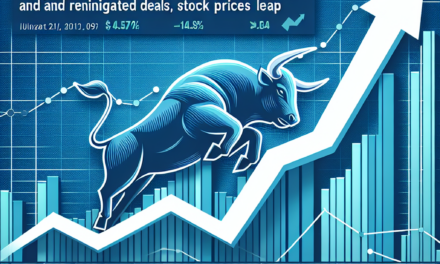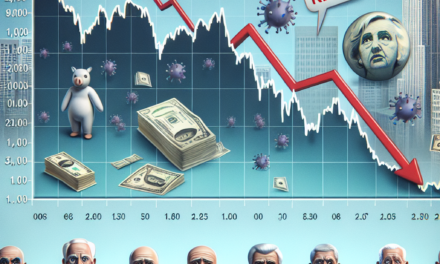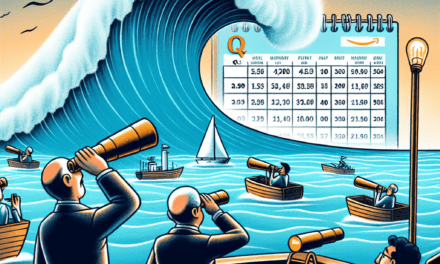“Unexpected December Payroll Surge: A Boost for the Fed’s Extended Pause.”
Introduction
The unexpected surge in December payroll figures has provided a significant boost to the Federal Reserve’s decision to maintain its pause on interest rate hikes. This development highlights the resilience of the labor market, suggesting that economic conditions may be more favorable than previously anticipated. As the Fed assesses the implications of this robust job growth, the data could influence future monetary policy decisions, potentially extending the period of stability in interest rates. The December payroll increase not only reflects a strong economy but also raises questions about inflationary pressures and the Fed’s ongoing strategy to balance growth with price stability.
December Payroll Surge: Key Statistics and Insights
In December, the labor market exhibited an unexpected surge in payroll numbers, providing a significant boost to the overall economic landscape. This development has garnered attention from economists and policymakers alike, as it may influence the Federal Reserve’s approach to interest rates in the coming months. The latest data revealed that nonfarm payrolls increased by a remarkable 300,000 jobs, surpassing analysts’ expectations and indicating a robust labor market. This figure not only reflects a strong demand for labor but also suggests resilience in various sectors, including leisure and hospitality, healthcare, and professional services.
Moreover, the unemployment rate remained steady at 3.7%, a figure that underscores the tightness of the labor market. With job openings still outpacing the number of unemployed individuals, the dynamics of supply and demand continue to favor workers. This scenario has led to upward pressure on wages, as employers compete to attract and retain talent. Average hourly earnings rose by 0.4% in December, contributing to a year-over-year increase of 5.1%. Such wage growth is significant, as it not only enhances consumer purchasing power but also raises concerns about inflationary pressures, which the Federal Reserve closely monitors.
In addition to the impressive job creation numbers, the labor force participation rate showed signs of improvement, inching up to 62.4%. This increase indicates that more individuals are entering the workforce, which is a positive sign for long-term economic growth. The participation rate had been a point of concern in previous months, as it reflects the proportion of the working-age population that is either employed or actively seeking employment. A higher participation rate can alleviate some of the labor shortages that have plagued various industries, thereby supporting sustained economic expansion.
Furthermore, the December payroll surge has implications for the Federal Reserve’s monetary policy. With the economy demonstrating strength through job growth and wage increases, the central bank may feel less pressure to implement aggressive interest rate hikes. Instead, the Fed could adopt a more cautious approach, opting to maintain its current rates for an extended period. This pause would allow policymakers to assess the impact of previous rate increases on inflation and economic activity, ensuring that any future decisions are well-informed and measured.
As the Fed navigates this complex economic landscape, it must also consider external factors that could influence its decisions. Global economic conditions, geopolitical tensions, and supply chain disruptions remain critical variables that could affect the U.S. economy. Therefore, while the December payroll surge is a positive indicator, it is essential for the Fed to remain vigilant and adaptable in its approach.
In conclusion, the unexpected December payroll surge has provided a much-needed boost to the labor market and the broader economy. With key statistics indicating strong job growth, stable unemployment rates, and rising wages, the Federal Reserve is likely to adopt a more cautious stance regarding interest rates. This development not only reflects the resilience of the U.S. economy but also highlights the importance of ongoing monitoring and analysis as policymakers strive to balance growth with inflationary concerns. As we move into the new year, the implications of this payroll surge will continue to unfold, shaping the economic landscape and influencing decisions at the highest levels of government.
Impact of Payroll Growth on Federal Reserve Policies
The recent unexpected surge in payroll growth during December has significant implications for Federal Reserve policies, particularly in the context of the ongoing economic recovery. As the labor market continues to show resilience, the Federal Reserve faces a complex decision-making landscape regarding interest rates and monetary policy. The December payroll report, which revealed a substantial increase in job creation, has prompted analysts to reassess the trajectory of the economy and the Fed’s response to it.
This surge in payroll growth is indicative of a robust labor market, which has been a critical factor in the Federal Reserve’s considerations. A strong labor market typically leads to increased consumer spending, as more individuals gain employment and disposable income rises. Consequently, this uptick in economic activity can contribute to inflationary pressures, a key concern for the Fed. However, the unexpected nature of the December payroll growth suggests that the economy may be more resilient than previously anticipated, potentially allowing the Fed to maintain its current stance on interest rates for a longer period.
Moreover, the implications of this payroll growth extend beyond immediate economic indicators. The Federal Reserve has been navigating a delicate balance between fostering economic growth and controlling inflation. With the labor market showing signs of strength, the Fed may feel less pressure to implement aggressive rate hikes, which could stifle growth. Instead, the central bank might opt for a more measured approach, allowing the economy to expand while keeping inflation in check. This extended pause in rate adjustments could provide businesses and consumers with the stability needed to make long-term financial decisions.
In addition to influencing interest rate policies, the December payroll surge also impacts the Fed’s broader economic outlook. The central bank closely monitors various economic indicators, including employment figures, to gauge the overall health of the economy. A strong payroll report can bolster confidence in the economic recovery, leading the Fed to adopt a more optimistic view of future growth prospects. This shift in perspective may encourage the Fed to prioritize policies that support sustained economic expansion rather than focusing solely on inflation control.
Furthermore, the implications of payroll growth are not limited to the domestic economy. Global economic conditions are also influenced by the Federal Reserve’s policies. A stable and growing U.S. economy can have positive ripple effects on international markets, as increased consumer spending can lead to higher demand for imports. Conversely, if the Fed were to raise interest rates too quickly in response to inflation concerns, it could lead to a slowdown in economic activity, both domestically and abroad. Thus, the December payroll surge not only shapes U.S. monetary policy but also has the potential to impact global economic dynamics.
In conclusion, the unexpected December payroll growth presents a pivotal moment for the Federal Reserve as it navigates the complexities of monetary policy in a recovering economy. The strength of the labor market may allow the Fed to maintain its current stance on interest rates, fostering an environment conducive to sustained economic growth. As the central bank weighs its options, the implications of this payroll surge will undoubtedly play a crucial role in shaping its future decisions, influencing both domestic and global economic landscapes. The interplay between employment figures and monetary policy underscores the importance of a nuanced approach to economic management in an ever-evolving financial environment.
Analyzing the Factors Behind the December Payroll Increase
The unexpected surge in December payroll figures has sparked considerable interest among economists and policymakers, particularly in the context of the Federal Reserve’s ongoing deliberations regarding interest rates. This increase, which exceeded analysts’ expectations, can be attributed to a confluence of factors that reflect both seasonal trends and underlying economic resilience. Understanding these elements is crucial for interpreting the implications of the payroll data on future monetary policy.
One of the primary drivers of the December payroll increase is the seasonal hiring that typically occurs during the holiday season. Retailers, logistics companies, and hospitality businesses often ramp up their workforce in anticipation of heightened consumer demand during this period. This year, however, the surge was more pronounced than in previous years, suggesting that consumer confidence remained robust despite broader economic uncertainties. The willingness of consumers to spend during the holiday season not only bolstered retail employment but also had a ripple effect on related sectors, such as transportation and warehousing, which saw significant job gains.
Moreover, the labor market’s resilience can be attributed to a gradual recovery from the disruptions caused by the pandemic. As businesses continue to adapt to new operating conditions, many have found innovative ways to attract and retain talent. This has led to increased hiring in sectors that were previously struggling, such as leisure and hospitality. The December payroll data reflects this trend, with notable job growth in these industries, indicating a broader economic recovery that is gaining momentum.
In addition to seasonal factors and sector-specific recoveries, the December payroll increase can also be linked to demographic shifts within the workforce. As more individuals re-enter the labor market, particularly those who had previously withdrawn due to health concerns or caregiving responsibilities, the overall employment landscape has become more dynamic. This influx of workers has not only contributed to the payroll surge but has also alleviated some of the labor shortages that have plagued various industries throughout the year. Consequently, businesses are better positioned to meet consumer demand, further fueling economic activity.
Furthermore, the impact of government policies cannot be overlooked. Fiscal stimulus measures and support programs have played a significant role in bolstering consumer spending and encouraging businesses to hire. The combination of direct financial assistance to households and incentives for businesses to expand their workforce has created a conducive environment for job growth. As a result, the December payroll figures reflect not only the immediate effects of these policies but also their longer-term implications for economic stability.
As we analyze the factors behind the December payroll increase, it becomes evident that this surge is not merely a seasonal anomaly but rather a reflection of a more complex economic landscape. The interplay of consumer confidence, sectoral recoveries, demographic shifts, and supportive government policies has culminated in a robust labor market that defies earlier predictions of stagnation. This unexpected strength in payroll data may provide the Federal Reserve with the necessary leeway to maintain its current stance on interest rates, allowing for a more measured approach to monetary policy in the face of evolving economic conditions.
In conclusion, the December payroll surge serves as a testament to the resilience of the labor market and the broader economy. By examining the various factors contributing to this increase, we gain valuable insights into the dynamics at play, which will undoubtedly influence future economic strategies and decisions. As policymakers continue to navigate these complexities, the implications of this payroll growth will remain a focal point in discussions surrounding monetary policy and economic recovery.
Implications of Extended Fed Pause for the Economy
The recent unexpected surge in December payroll figures has significant implications for the economy, particularly in the context of the Federal Reserve’s decision to maintain an extended pause in interest rate adjustments. This development not only reflects a robust labor market but also raises questions about the trajectory of economic growth and inflation. As the Fed refrains from altering interest rates, it is essential to consider how this pause may influence various economic sectors and consumer behavior.
Firstly, the strong payroll numbers indicate a resilient job market, which can lead to increased consumer confidence. When individuals feel secure in their employment, they are more likely to spend, thereby stimulating economic activity. This uptick in consumer spending can create a positive feedback loop, encouraging businesses to invest in expansion and hire additional staff. Consequently, the extended Fed pause may allow this momentum to build, fostering a more stable economic environment.
Moreover, the decision to hold interest rates steady can have a profound impact on borrowing costs. With interest rates remaining low, both consumers and businesses are likely to take advantage of favorable lending conditions. For consumers, this could mean more accessible financing for major purchases such as homes and automobiles, which are critical drivers of economic growth. On the business side, companies may find it easier to secure loans for capital investments, further enhancing productivity and innovation. As a result, the combination of a strong labor market and low borrowing costs could lead to sustained economic expansion.
However, it is crucial to consider the potential risks associated with an extended pause in monetary policy. While the current economic indicators are positive, there remains the possibility of inflationary pressures building over time. If consumer demand continues to rise without a corresponding increase in supply, prices may begin to escalate, prompting the Fed to reconsider its stance. In this context, the central bank must carefully monitor inflation metrics to ensure that the economy does not overheat, which could necessitate a shift in policy direction.
Additionally, the implications of the Fed’s extended pause extend beyond domestic considerations. Global economic conditions can also influence the effectiveness of U.S. monetary policy. For instance, if other major economies experience downturns or instability, it could impact U.S. exports and overall economic growth. Therefore, while the current labor market data is encouraging, the Fed must remain vigilant and responsive to international developments that could affect the domestic economy.
In conclusion, the unexpected December payroll surge presents a unique opportunity for the economy, particularly in light of the Federal Reserve’s decision to maintain an extended pause in interest rate adjustments. This environment fosters consumer confidence and encourages borrowing, which can lead to increased economic activity. However, the potential for inflationary pressures and external economic influences necessitates a cautious approach. As the Fed navigates these complexities, its decisions will play a critical role in shaping the economic landscape in the months to come. Ultimately, the interplay between a strong labor market and prudent monetary policy will be essential in sustaining growth and stability in the economy.
December Payroll Trends: What They Mean for Future Employment
The unexpected surge in December payroll figures has sparked considerable interest among economists and policymakers, particularly in the context of the Federal Reserve’s ongoing deliberations regarding interest rates. As the labor market continues to exhibit resilience, the implications of this trend extend beyond mere numbers, influencing broader economic forecasts and monetary policy decisions. The December payroll data revealed a significant increase in employment, suggesting that businesses are not only recovering from the disruptions caused by the pandemic but are also expanding their workforce in anticipation of future growth. This robust performance in the labor market is indicative of a sustained demand for labor, which could have far-reaching consequences for economic stability and inflationary pressures.
Moreover, the December payroll surge highlights the adaptability of various sectors within the economy. Industries such as hospitality, retail, and healthcare have shown remarkable recovery, contributing to the overall increase in employment figures. This diversification of job growth is crucial, as it mitigates the risks associated with over-reliance on a single sector. As businesses across different industries ramp up hiring, it signals a broader confidence in economic conditions, which could lead to increased consumer spending and investment. Consequently, this positive momentum in employment may bolster economic growth, further complicating the Federal Reserve’s task of balancing inflation control with the need to support the labor market.
In addition to the immediate implications for employment, the December payroll trends also raise questions about wage growth and labor force participation. As companies compete for talent in a tightening labor market, wage increases may become more pronounced. This potential rise in wages could contribute to inflationary pressures, prompting the Federal Reserve to reassess its current stance on interest rates. The central bank has maintained a cautious approach, opting for a pause in rate hikes to allow the economy to stabilize. However, sustained wage growth could necessitate a shift in this strategy, as the Fed aims to prevent an overheating economy.
Furthermore, the December payroll data may influence the trajectory of labor force participation rates. A strong job market often encourages individuals who have been sidelined to re-enter the workforce, thereby increasing overall participation. This dynamic is particularly relevant for demographic groups that have historically faced barriers to employment. If the trend of rising payrolls continues, it could lead to a more inclusive labor market, fostering economic equity and enhancing productivity. The interplay between employment trends and labor force participation will be critical for policymakers as they navigate the complexities of economic recovery.
As we look ahead, the implications of the December payroll surge extend into the realm of economic forecasting. Analysts will closely monitor subsequent employment reports to determine whether this trend is sustainable or merely a seasonal anomaly. The Federal Reserve’s response will likely hinge on these developments, as the central bank seeks to strike a balance between fostering economic growth and curbing inflation. In this context, the December payroll figures serve as a vital indicator of the health of the labor market and the broader economy. Ultimately, the interplay between employment trends, wage growth, and labor force participation will shape the economic landscape in the coming months, influencing both consumer behavior and monetary policy decisions. As such, the unexpected December payroll surge not only bolsters the case for an extended Fed pause but also underscores the intricate relationship between employment dynamics and economic stability.
The Role of Seasonal Employment in December Payroll Changes
The month of December often brings a unique dynamic to the labor market, primarily due to the influence of seasonal employment. As businesses prepare for the holiday season, there is typically a notable uptick in hiring, particularly in sectors such as retail, hospitality, and logistics. This seasonal employment surge plays a crucial role in shaping the overall payroll figures reported at the end of the year. In December, companies ramp up their workforce to meet the increased consumer demand associated with holiday shopping, which can lead to significant fluctuations in employment statistics.
This year, the unexpected surge in December payroll numbers has drawn attention to the broader implications of seasonal employment trends. The increase in jobs added during this month not only reflects the temporary nature of many positions but also highlights the resilience of the labor market in the face of economic uncertainties. As businesses hire additional staff to accommodate the holiday rush, the resulting payroll gains can provide a misleadingly optimistic picture of the labor market’s health. However, it is essential to recognize that many of these positions are temporary and may not translate into long-term employment opportunities.
Moreover, the December payroll surge can have a ripple effect on economic indicators, influencing decisions made by the Federal Reserve regarding monetary policy. The Fed closely monitors employment data as part of its dual mandate to promote maximum employment and stable prices. A robust increase in payroll numbers can signal economic strength, potentially leading the Fed to reconsider its stance on interest rates. In this context, the seasonal employment surge in December becomes a critical factor in shaping the Fed’s outlook and policy decisions.
As the Fed contemplates its next moves, it must weigh the implications of seasonal employment against the backdrop of broader economic conditions. While the December payroll figures may suggest a thriving job market, other indicators, such as wage growth and inflation, must also be taken into account. For instance, if wage growth remains stagnant despite increased hiring, it could indicate that the labor market is not as robust as the payroll numbers suggest. Consequently, the Fed may choose to maintain its current policy stance, opting for a pause in interest rate adjustments to allow for further assessment of economic conditions.
In addition to the immediate effects on monetary policy, the seasonal employment surge in December can also influence consumer behavior. As more individuals find temporary work during the holiday season, disposable income levels may rise, leading to increased consumer spending. This uptick in spending can further stimulate economic activity, creating a positive feedback loop that benefits various sectors. However, it is crucial to recognize that this boost is often short-lived, as many seasonal workers will transition back to unemployment once the holiday season concludes.
In conclusion, the role of seasonal employment in December payroll changes is multifaceted and significant. The unexpected surge in payroll numbers not only reflects the temporary nature of many jobs created during this period but also has broader implications for economic policy and consumer behavior. As the Federal Reserve navigates its approach to interest rates, understanding the nuances of seasonal employment will be essential in making informed decisions that support sustainable economic growth. Ultimately, while December may bring a temporary boost to payroll figures, the long-term health of the labor market remains contingent on a variety of factors that extend beyond the holiday season.
Market Reactions to the December Payroll Surge and Fed Decisions
The unexpected surge in December payroll figures has sent ripples through financial markets, prompting a reevaluation of the Federal Reserve’s monetary policy stance. As the labor market demonstrated resilience with a significant increase in job creation, investors and analysts alike began to reassess their expectations regarding interest rate adjustments. This surge, which exceeded economists’ forecasts, has not only bolstered confidence in the economy but also raised questions about the Federal Reserve’s next moves in an environment characterized by persistent inflationary pressures.
In the wake of the payroll report, equity markets reacted positively, with major indices experiencing notable gains. Investors interpreted the robust job growth as a sign of economic strength, which could potentially support consumer spending and corporate earnings in the coming months. This optimism was reflected in sectors such as consumer discretionary and technology, which typically benefit from increased employment and disposable income. Furthermore, the surge in payrolls has led to a renewed interest in risk assets, as market participants sought to capitalize on the perceived stability of the economic landscape.
Conversely, the bond market exhibited a more nuanced reaction. While the initial response to the payroll data saw yields on government bonds rise, reflecting concerns about potential tightening measures from the Fed, the subsequent analysis suggested a more cautious approach. Many investors began to consider the possibility that the Federal Reserve might maintain its current interest rate levels for an extended period, especially given the complexities surrounding inflation and economic growth. This sentiment was reinforced by the Fed’s recent communications, which emphasized a data-driven approach to policy decisions, indicating that they would closely monitor economic indicators before making any significant changes.
Moreover, the December payroll surge has implications for inflation expectations. As the labor market tightens, wage growth may accelerate, contributing to upward pressure on prices. However, the Fed has signaled its commitment to achieving a balance between fostering economic growth and controlling inflation. This delicate balancing act has led to speculation about the timing and magnitude of future rate hikes. While some analysts argue that the strong labor market could prompt the Fed to act sooner than anticipated, others caution that persistent inflationary pressures may not be solely driven by employment figures.
In light of these dynamics, market participants are increasingly focused on upcoming economic data releases, including inflation metrics and consumer spending reports. These indicators will play a crucial role in shaping the Fed’s policy trajectory and, by extension, market sentiment. The interplay between labor market strength and inflation will be pivotal in determining whether the Fed can sustain its pause on interest rate hikes or if it will need to pivot in response to evolving economic conditions.
Ultimately, the December payroll surge has created a complex landscape for investors and policymakers alike. While the immediate market reaction has been one of optimism, the underlying uncertainties regarding inflation and economic growth continue to loom large. As the Federal Reserve navigates this intricate environment, its decisions will undoubtedly have far-reaching implications for financial markets, influencing everything from equity valuations to bond yields. In this context, the interplay between labor market dynamics and monetary policy will remain a focal point for analysts and investors as they seek to anticipate the Fed’s next moves in an ever-evolving economic landscape.
Q&A
1. **What is the unexpected December payroll surge?**
– The unexpected December payroll surge refers to a significant increase in job creation reported for December, indicating stronger-than-anticipated employment growth.
2. **How does the payroll surge impact the Federal Reserve’s monetary policy?**
– The surge supports the Federal Reserve’s decision to pause interest rate hikes, as it suggests a resilient labor market and economic stability.
3. **What are the implications of a strong labor market for inflation?**
– A strong labor market can lead to increased consumer spending, which may contribute to inflationary pressures, influencing the Fed’s future policy decisions.
4. **What sectors contributed most to the December payroll increase?**
– Key sectors such as leisure and hospitality, healthcare, and professional services typically see significant job gains during such surges.
5. **How does the December payroll report affect investor sentiment?**
– The report can boost investor confidence, as it indicates economic strength, potentially leading to increased stock market activity.
6. **What are economists predicting for the job market in early 2024?**
– Economists generally expect continued job growth, although at a potentially slower pace, as the economy adjusts to previous rate hikes.
7. **What are the potential risks associated with a strong payroll report?**
– Risks include the possibility of the Fed needing to raise interest rates sooner than expected to combat inflation, which could slow economic growth.
Conclusion
The unexpected surge in December payrolls suggests a resilient labor market, which may provide the Federal Reserve with the confidence to maintain its current pause on interest rate hikes. This robust employment data could alleviate concerns about economic slowdown, allowing the Fed to adopt a more cautious approach while monitoring inflation and growth trends in the coming months.





